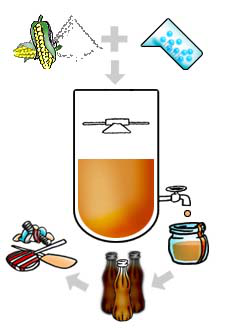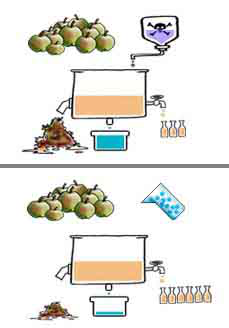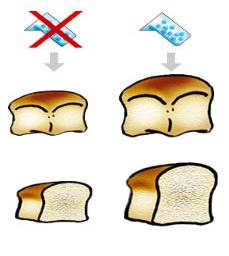The global beauty industry is undergoing a transformation as consumers increasingly demand products that demonstrate transparency, ethical sourcing, and ingredient purity...
Halal certification regulations for enzyme preparations
2025-05-15
Enzymes are macromolecular substances with biocatalytic properties. Enzymes are biocatalysts that do not participate in reactions themselves. Most enzymes are proteins. Enzymes are primarily derived from animals, plants, and microbial fermentation.
The relationship between enzymes and food
In food processing, it is crucial to maintain the color, aroma, flavor, and texture of food. Therefore, it is important to avoid violent chemical reactions during processing. Enzymes operate under very mild conditions, making them ideal catalysts for food processing. For food scientists, the rational use and control of enzymes is a crucial topic worthy of careful study and mastery. Enzymes play a crucial role in food preservation and processing. Many enzyme-catalyzed reactions begin during the initial growth of a crop. When the crop is harvested for food, the catalytic activity of the enzymes continues within the organism. After the animal dies, its anabolism ceases, while catabolism accelerates, leading to tissue decay. However, this is not necessarily a negative factor, as it may improve the flavor of certain food ingredients. In most ripe fruits, the increase in certain enzymes accelerates respiration, converts starch to sugar, degrades chlorophyll, and rapidly increases cell volume. These changes are beneficial for improving the flavor of the fruit; however, in vegetables, chlorophyll degradation is detrimental.
The important role of enzymes in the food industry
In recent years, enzyme engineering has also successfully processed starch into maltose, maltose, high maltose syrup, maltodextrin, coupled sugars,( A sweet cyclodextrin) Various starch sugar products, such as lipase, play an important role in the food industry. For example, lipase is used in the flavoring of dairy products, defatting of fish fillets, edible oil processing, detergent enzyme addition, defatting of leather, fur, and silk, pharmaceuticals, chemical synthesis, sewage treatment, and as a tool enzyme.[7]Multiple uses. Maltose can be absorbed by the liver even in the absence of insulin without causing an increase in blood sugar levels, so it can be consumed by diabetic patients; maltitol, which is reduced from maltose, is the sweetener with the lowest calorie content and can be consumed by patients with diabetes, hypertension, and obesity. Maltodextrin is odorless, tasteless, colorless, has low hygroscopicity, high viscosity, and good dispersibility when dissolved. It is used in foreign food industries to improve the flavor of food; it is used in the candy industry to adjust the sugar content and prevent sucrose from crystallizing and absorbing moisture; it is used in the beverage industry as a thickener and foam stabilizer, and is also used in the manufacture of powdered beverages to accelerate drying; it is used to thicken and extend the shelf life when making solid soy sauce and soup powder because it is not easy to absorb moisture and agglomerate. Coupling sugars are not likely to cause tooth decay when used in food, and are used as food additives for emulsification, stabilization, foaming, flavor preservation, and debittering.
1, enzymes for the production of starch sugar
Starch is used as raw material and hydrolyzed by α-amylase and glucoamylase to obtainD- glucose, which is immobilized byD—Glucose isomerase column completed byD- Glucose toD—The conversion of fructose, followed by refining and concentration, can produce different types of high fructose syrup.

picture:Enzymes convert starch in crops like corn or wheat into sugar
2, enzymes used in the production of sweeteners
Starch sugar is produced with starch as raw material, and its sweetness is limited. Therefore, to fundamentally solve the problem of sugar shortage, we should produce sweeteners with high sweetness but not starch as raw material.APM) is a high-intensity sweetener. Aspartame (aspartame) is a dipeptide sweetener with a sweetness of sucrose.200times. In the past,L—Aspartic acid andL- Phenylalanine is synthesized by chemical method. Now Japan uses the new process of enzyme synthesis, which is available at a lower price.DL-phenylalanine is used as raw material, and the products are all α-type (β-type has a bitter taste), which reduces production costs 30% 。
3, enzymes for dairy processing
(1) Cheese production
The world's cheese production consumes1More than 100 million tons, accounting for 10% of the total milk production1/4The first step in cheese production is to ferment milk with lactic acid bacteria to make yogurt, and then add rennet to hydrolyze it.K-Casein, under acidic conditions, calcium ions cause the casein to coagulate, and then it is cut into pieces, heated, pressed and matured.
(2) Break down lactose
Milk contains4.5%Lactose. Lactose is a disaccharide that lacks sweetness and has a very low solubility, making it difficult to digest. This is why some people often experience diarrhea, abdominal pain, and other ailments after drinking milk. Furthermore, because lactose is poorly soluble in water, it often forms sandy crystals in condensed milk and ice cream, affecting the flavor. Treating milk with lactase, which hydrolyzes the lactose into galactose and glucose, can address this problem.
(3) Butter for flavor

The unique aroma of dairy products is mainly due to volatile substances (such as fatty acids, alcohols, aldehydes, ketones, esters and amines) produced during processing. Adding an appropriate amount of lipase during dairy processing can enhance the aroma of cheese and butter. Using flavored butter in foods such as candies and cakes can save butter and improve flavor.
(4) Infant formula
One of the differences between human milk and cow's milk is the lysozyme content. Egg white lysozyme is added to milk powder to prevent intestinal infections in infants.
4, enzymes for meat and fish processing
(1) Improve texture and tenderize meat
Enzyme technology can tenderize meat. Beef and other less textured meats (such as meat from older animals) have high collagen and elastin content and complex structures in their connective tissue and muscle fibers. Collagen is a fibrous protein, connected by cross-links that provide strong mechanical strength. These cross-links can be categorized as either heat-resistant or heat-insensitive. The collagen of young animals contains more heat-insensitive cross-links, which break down upon heating, resulting in tender meat. Conversely, meat from older animals, with its more heat-resistant cross-links, is more difficult to soften during cooking, resulting in a rough texture, difficulty cooking, and a poorer taste. Proteases can be used to break down the collagen in muscle connective tissue, thereby tenderizing the meat. Proteases used as tenderizing agents can be divided into two categories: the most commonly used are plant proteases and the other are microbial proteases.
(2) Transform waste protein
Using protease to hydrolyze waste proteins, such as trash fish, animal blood, and minced meat, and extracting the protein for consumption or use as feed is an effective measure to increase human protein resources. Among them, the utilization of trash fish and fish factory waste is the most eye-catching. Many fish in the ocean are not edible due to their poor color, appearance, or taste, but these fish account for up to 10% of marine aquatic products.80%This new biotechnology achievement allows most of the protein to be dissolved, and after concentration and drying, a product with high nitrogen content and rich in various water-soluble vitamins can be made. Its nutritional value is no less than that of milk powder, and it can be added to bread, noodles, etc. for consumption, or used as feed, with significant economic benefits.
(3) Other applications
With acid proteasepHThawing fish under neutral pH conditions can remove the fishy smell. Alkaline protease is currently being developed to hydrolyze animals for decolorization to produce colorless blood meal, a cheap and safe protein supplement. This technology has been used in industrial production.
5, enzymes for fruit and vegetable processing
(1) Canned fruit processing
Canning oranges requires removing the citrus peel. Previously, alkaline treatment was used, which was water-intensive and time-consuming. Now, a mixture of hemicellulase, pectinase, and cellulase produced by Aspergillus niger effectively removes the peel, avoiding these drawbacks. Canned oranges often have a turbid white appearance, caused by hesperidin in the flesh. Hesperidinase can hydrolyze hesperidin into water-soluble hesperetin, eliminating the turbidity. Peaches contain red anthocyanidins, which react with metal ions to develop a purple-brown color during canning. Using anthocyanidase to treat peach jam, grape juice, and other products can decolorize and increase their economic value. This is because anthocyanidase hydrolyzes anthocyanidins, rendering them colorless.
(2) Debittering citrus fruits
Debittering citrus fruits has long been a major challenge in fruit processing. Limonin in oranges is responsible for the bitter taste of orange juice, but this bitterness can be eliminated by treating it with limonase, a enzyme derived from immobilized cells of Arthrobacter sphaeroides.
(3) Juice processing
All fruits contain pectin. One of pectin's key properties is its ability to form a gel in the presence of acid and high sugar concentrations. This property is the basis for making jellies and jams. However, it makes juice processing difficult during pressing and clarification. Treating crushed fruit with pectinase can accelerate juice filtration and clarification.

Image: Enzymes break down fiber during juice making
(4) Fruit and vegetable preservation
Using glucose oxidase to remove sugar from dehydrated vegetables prevents browning during storage. Bottled orange juice deteriorates in color, flavor, and aroma due to oxidation during storage. Using glucose oxidase and catalase to remove oxygen can preserve the juice's original color, flavor, and aroma. Frozen fruit can also be preserved by fermenting and spoiling due to the action of its own enzymes.
6, enzymes for baked goods
Add α-Amylase can regulate the amount of maltose produced, balancing the production of carbon dioxide and the gas retention of the dough. Adding protease can promote gluten softening, increase extensibility, reduce kneading time and energy, and improve fermentation results. Pasta made from flour fortified with protease has good extensibility and flavor.-Amylase-enriched flour can prevent pastries from aging. Pastry fillings often use starch as a filler, and adding β-Amylase can improve the flavor of fillings. In pastry making, invertase can hydrolyze sucrose into invert sugar, thereby preventing syrup crystallization. Adding lipase appropriately in bread making can enhance the flavor of bread, because lipase can decompose the trace amount of glycerol esters of alcoholic acid or keto acid in milk fat, thereby generating delta-Fragrance substances such as lactones or ketones.

Image: Enzymes make bread softer and last longer
7, enzymes used in winemaking
Beer is an alcoholic beverage made from malt through saccharification and fermentation. Malt contains various enzymes necessary for fermentation.-Amylase, β-Enzyme preparations such as glucanase can supplement the deficiency of enzyme activity.
The use of acid protease, amylase and pectinase in fruit wine brewing can eliminate turbidity and improve the juicing operation of crushed fruits.
Using saccharifying enzyme instead of bran koji in liquor production can improve the liquor yield2%~7%This can not only save food, but also simplify equipment and save factory space.
Several common enzymes in the food industry
1.a-amylase
Widely distributed in animals (saliva, pancreas, etc. ) plants (malt, jatropha) and microorganisms 。a-Amylase has liquefaction and saccharification effects and is often used as a sweetener in the beverage industry. In cold drinks, it reduces the viscosity of cold drinks and increases fluidity, ensuring the taste of high-starch cold drinks. In the flour products industry, it is used as a safe and efficient improver to improve the quality of bread. In addition, it is resistant to high temperatures.a-As a new type of liquefaction enzyme preparation, amylase is widely used in the fermentation industry. Its thermal stability is determined by the thermal stability of the protein itself, so it is widely used in beer brewing and alcohol industry.
2.Papain
Papain is a widely used plant protease. It is pure natural, safe and non-toxic. It is widely used in the food processing industry and is a food additive. It has been widely used in industries such as beer brewing and meat tenderizing.
The enzymatic reaction of papain hydrolyzes macromolecular nutrients (such as protein, fat, maltose, and cellulose) in food into small molecules such as amino acids or peptides, which aid digestion and are easily absorbed by the body. This enzyme is ideal for the nutritional needs of patients with frail health or digestive system diseases, and is particularly beneficial for digestion and absorption by the elderly, children, and the sick. Papain can effectively convert meat-based soups into high-end convenience foods. It can be used to make meat tenderizers, wine clarifiers, biscuit softeners, high-end oral liquids, health foods, and nutritious foods.
3.Pectinase
Pectinase is an enzyme that breaks down pectin, the main component of plants. Pectinase is widely distributed in higher plants and microorganisms. Pectinase is used in the food industry for clarification of fruit juice and wine, extraction of fruit and vegetable juice, maceration and liquefaction of fruits and vegetables, production of single-cell fruit and vegetable juices, and peeling of fruits.
4.Pepsin
Pepsin (English name:Pepsin) is a digestive protease secreted by the chief cells of the gastric mucosa in the stomach
5.lipase
Lipase is widely found in animals, plants, and microorganisms. Its primary application in dairy products is in cheese production, where it accelerates cheese ripening, shortens the ripening time, and improves production efficiency. Current cheese production typically involves the simultaneous addition of proteases and lipases to promote cheese ripening and develop its unique flavor. Lipase can also be added to cream to enhance its flavor.
6.b-amylase
Also known as starch beta-1,4-Maltosidase is a type of amylase that is widely found in higher plants such as barley, wheat, sweet potato, soybean, and microorganisms such as Bacillus.(maltose syrup)Main saccharifying agents produced
7.rennet
Rennet exists in animals (mammalian gastric juice), plants and microorganisms. The food industry mainly uses it in cheese processing.
1.If the enzyme is extracted directly from an animal, then the enzyme is considered halal if the animal is halal.
2.If the enzyme is extracted through microbial fermentation, the key point is the culture medium. The enzyme can only be considered halal if the culture medium used does not contain non-halal ingredients.
